The Clang Roses
¡@
At the National Day military review, there were fourteen square arrays. The last one drew the most attention. They are the Beijing Women's Militia, whose contingent has been dubbed the "clang roses." "Clang" means strong and powerful, while "rose" is the pink/red color of their uniforms.
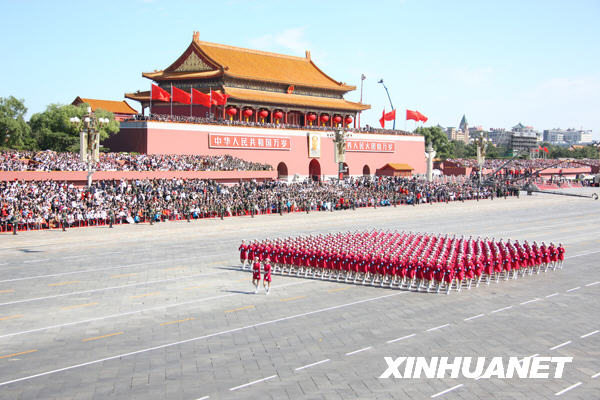
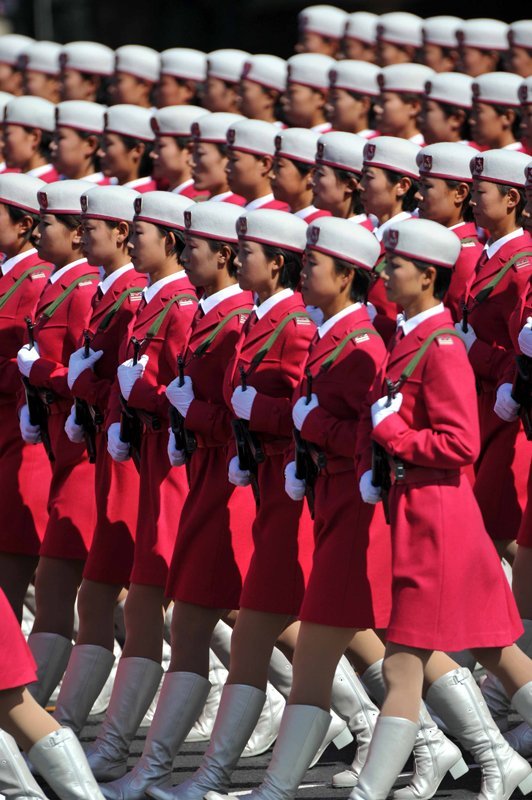
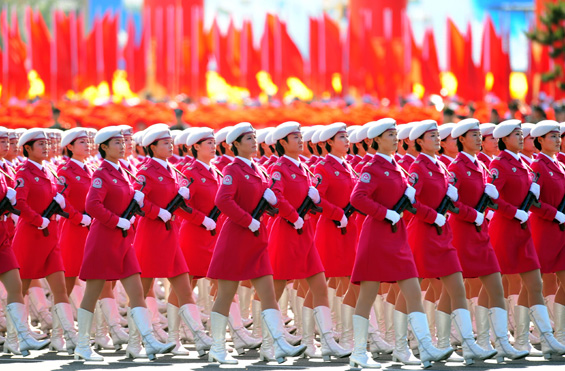
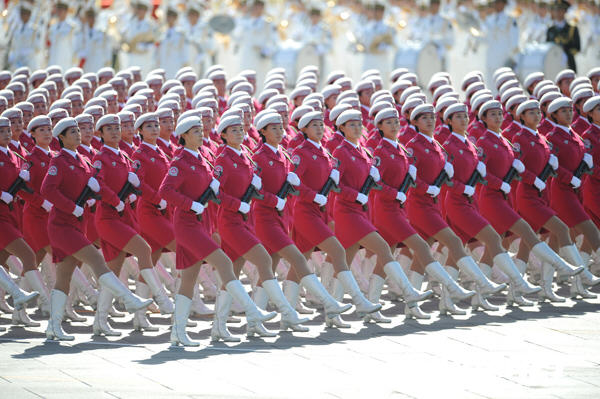
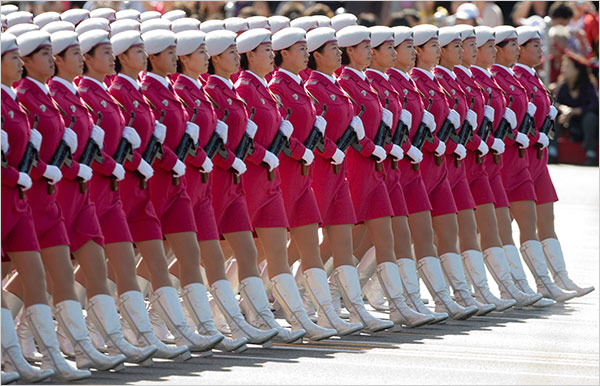
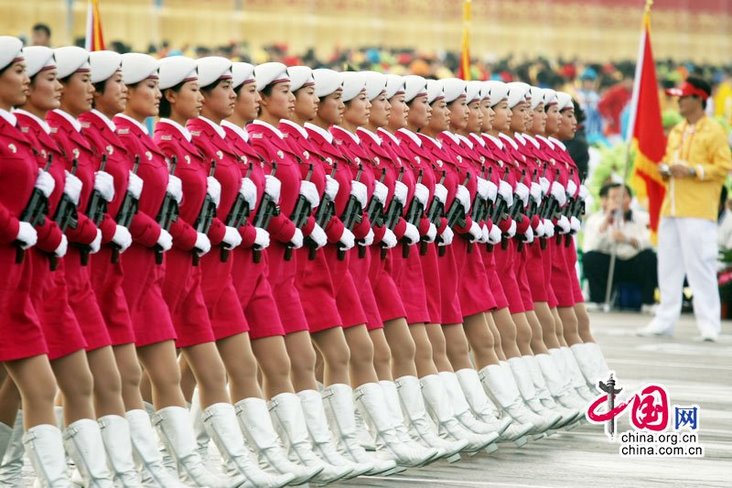
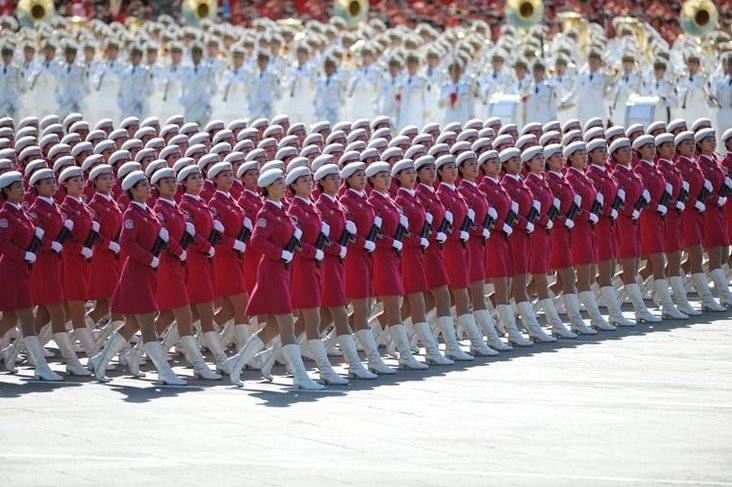
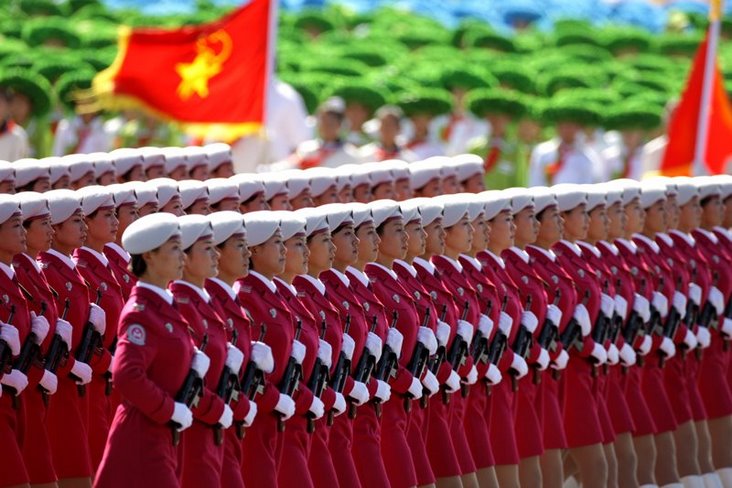
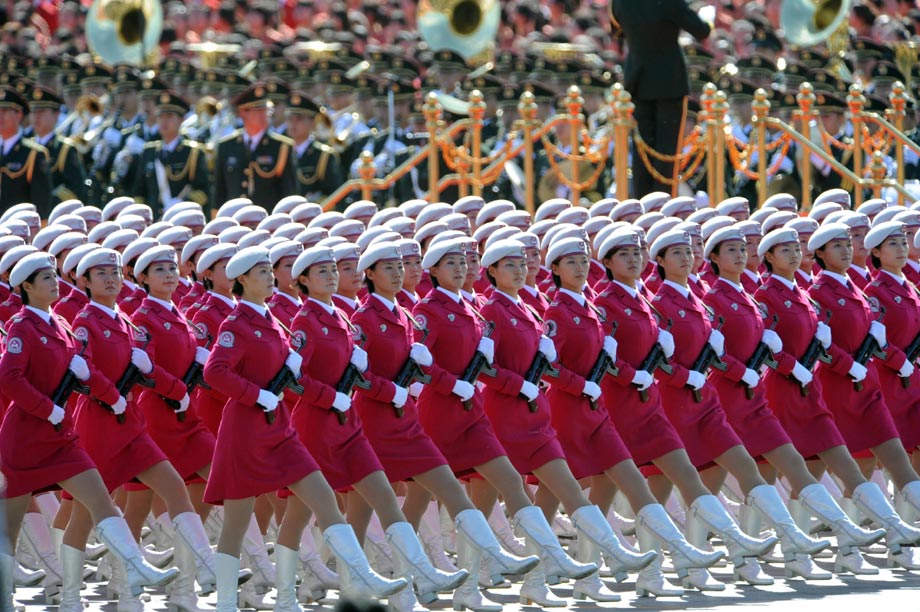
(Jiefangjunbao) October 2, 2009.
A dazzling square formation of women wearing rose-colored suits marched towards Tiananmen with their heads and shoulders held up high.
This special formation is known as "the flowers of the capital militia": their average age is 21.2 years and they are graceful and valiant. Among the fourteen square formations, they were the climatic final group. They represent the several million militia around China. Their appearance caused innumerable pleasant surprises.
The militia participated in the military review the first time in 1958. On September 29, the Chinese Communist Central Committee made the decision to build up the militia. On October 1, more than 600,000 participated in the celebration and marches of National Day. A militia square formation composed of workers, peasants and students were amongst those in the reviewed formations. The female militia square formation also made its first appearance.
As the years go by, the excellent tradition of female militia square formation continued. They marched powerfully and flawlessly. Their excellent performance reflects the honor accorded to this valiant square formation.
These flaming red roses live in different parts of the city and are engaged in different lines of work. They all work for around 100 units in the Chaoyang district of Beijing city. They include university students, corporate workers, private company owners, village officials and even new mothers.
Patriotism made them send in their applications to take part in the grueling training. They regard this military review as a way station in their lives. They made strict demands of themselves and aimed for excellence everywhere.
Their tall bodies, their elegant qualities and their crisp actions brought them through Tiananmen. The two leaders in front, Zhao Na and Zhang Xiaofei, come from the Zhonghua Women's Academy who major in ad modeling and image design. They postponed their graduation because they wanted to participate in the military parade.
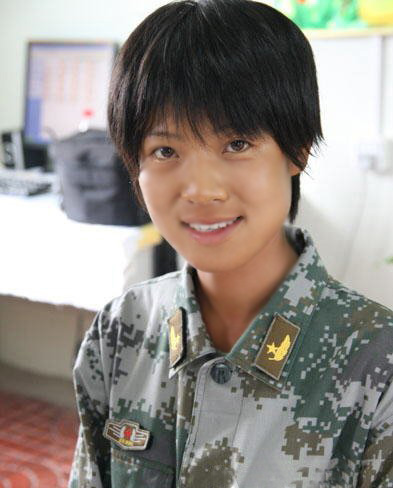
It was a tough road from the university campus to the military training camp. At first, the two did not even know how to stand at attention or at ease. Their leg kicks were weak, for which they earned the nickname "limp noodles" from their teammates. So they made a pact: "We will do whatever the others can do. No matter how painful or tiring, we must persist."
From then on, their teammates found them doing extra training on the training grounds as well as living quarters. When the others do 20 push-ups, they do 50; when others do leg kicks for 5 minutes, they do 15 minutes; after completing the daily marching step rehearsal, they do another 500 steps themselves.
Their faces became tanned and their skins became rough. Their university teacher was worried: "How can you go in front of the camera in the future?" But they had no reservations. Their training performance improved dramatically. They were selected as the leaders of the female militia square formation. "Coming here for the military review is like going to the battlefield. The call from the motherland must be answered with concrete action." The two beautiful girls said with strength coming out of their gentleness.
"I will give you my youth and blood just like I repay my parents for bringing me up." Zhang Yuanyuan had been studying and working in Singapore for five years. She earns more than 20,000 RMB per month. She even has a "green card" there. But the material conditions do not her longing for her homeland. When she learned about the military review, she ignored the advice of her friends and relatives and returned to China to apply for the team.
During the training, Zhang Yuanyuan was extremely self-confident, strong and optimistic. She had a stress fracture in her pelvic bone which caused extreme pain every step that she marched. But she did not retreat. She wrote in her diary: "Persist! No stopping! Never give up!" Whenever the reporter encounter Zhang Yuanyuan in the training camp, she always wore a beaming smile.
Compared to the previous National Day parades, the female militia police square formations had a brand new sub-group this year: there are eight "village officials" who are university graduates. They come from eight villages in the Chaoyang district jurisdiction. Although these young women were all born in the 1980's, they all have at least a bachelor's degree and they hold multiple job positions in their villages.
Lin Lin is a graduate students at the Beijing Industrial University's Corporate Management School. Last July, she was faced with a career choice. She decided to work in a rural Beijing village as an ordinary grassroots cadre. Six months later, Lin Lin was promoted to assistant to the mayor on the basis of her steadiness, pragmatism, diligence, willingness to learn and support among villagers. When she learned about the military review, she did not hesitate to apply immediately. Lin Lin said: "It is a once-in-a-lifetime chance to participate in the National Day military parade. I must treasure this rare opportunity to gain experience for myself."
(CCTV) Young women from Chaoyang District compete to join National Day parade September 28, 2009.
In rose color uniforms, they will form an infantry group which will be inspected during the 60th National Day parade. Though they are not professional soldiers, their lineup is still imposing and vigorous.
Their average age in 21 years old and all of them come from Chaoyang District-based government departments, schools, hospitals and businesses.
They reflect the outlook of China's female militia members
This is the third time Chaoyang District has been able to form a female militia group
In November 2008, higher authorities urged Chaoyang District to establish a female militia group. The Department of People's Armed Forces of Chaoyang District is responsible for the selection, establishment and training of the militia group.
Quickly, selection of the militia members was conducted in neighborhoods, communities, businesses and public institutions in the district. The National Day parade is a grand ceremony which rarely takes place, and participating in it is a precious opportunity for those who were born in 1980's and 1990's. "Let's go to sign up for the military parade" was on the lips of many young women in Chaoyang District.
During that period of time, many young women went to registration spots. Among them were overseas Chinese students who had just returned to China, white collar clerks who had quit their jobs, a community healthcare center nurse who had quit the nationwide final of "the Miss Tourism International" contest, and students who were in the process of pursuing master's degrees.
Those who were born in 1990's are not the "strawberry generation" any more
46.3 percent of the female militia group members are the only child in their families and many of them come from a comfortable background. They are called the "strawberry generation" because they live in a comfortable environment and cannot cope with setbacks.
At the beginning of their time at the parade village, some female militia members would cry just because they failed to adapt to the training, had not been praised in several days or had been away from home for one week. Several months later, however, they became qualified soldiers and 43 members joined the CPC.
At the age of 18, Liu Jiaxin is the youngest member of the female militia. She lived a carefree life before participating in the training. "When I stayed home, I hardly did housework including washing dishes." Liu smiled shyly. When she first joined the women militia group, she relied on others to fold up her quilt. Leaders urged every member to fold up their quilt neatly every day and she would ask others to do it for her. She even did not use her quit at night. After several months of training, Liu Jiaxin has changed completely. Now, she is very industrious, washing clothes, sweeping the floor and giving a helping hand to others.
On her birthday, other group members held an adulthood ceremony for her. Receiving congratulations from leaders and other group members, she said: "This is the most meaningful birthday in my life and what I have learnt in the training is the best birthday gift I could have received."
Chinese militia
Chinese militia members are civilians during peace time and soldiers during war time. During the war years, they launched a guerrilla war behind the enemy lines. They also played an important role in supporting the frontline and providing logistical support.
During peace time, militia members play a key role in dealing with emergencies and disasters, building water conservancy projects, planting trees and undertaking key projects.
It is important to learn more about military reforms and to keep pace with the times. The Chinese militia has set up an electronic countermeasure and computer network units, providing reliable support to the PLA to protect the country.
(South China Morning Post) Militia in miniskirts steals show at parade By Kristina Kwok. October 3, 2009.
With impeccable make-up and eye-catching miniskirts, the phalanxes of female soldiers are the talk of the town after the massive military parade strode through Tiananmen Square on Thursday, impressing the world. Forget the intercontinental missiles and state-of-the-art tanks. The troupe and their miniskirts aroused heated discussion on the internet, as their pictures flooded forums.
Standing out from a sea of military green and navy blue was the array of female militia in pink skirts, white above-the-calf boots and white berets. Internet users immediately launched "human flesh search engines" to investigate the two leaders of the troop, whom they called the "most beautiful phalanx marchers". Before the parade, Zhang Xiaofei and Zhao Na had already made headlines given their backgrounds as models and ritual girls in last year's Olympic Games.
As pictures of them doing the goose-step hit the internet, many curious minds dug further and found that Zhao was a model for Audi and Mercedes-Benz print advertisements, and Zhang had modelled for L'Oreal and mainland brand Bosideng apparel, the Huaxi Metropolis Daily reported yesterday.
The pair's modelling shots - including some of them wearing bikinis - have already spread on blogs and other forums. The shift from model to marcher apparently did not come easily: the pair reportedly had to work extra hard - doing 20 more push-ups and 500 more goose-steps daily - since training began in December. Both are originally from Shandong , stand 1.78 metres tall and are fourth-year students at China Women's University in Beijing.
Another detail during the parade that was much talked about was a smile on the otherwise grim face of President Hu Jintao when the women marched past the Gate of Heavenly Peace. Perhaps it was the broadcast director's sense of humour to intentionally highlight Hu's pleasure; the camera quickly panned towards a smiling Hu, clapping his hands, when the women's corps came into sight. For the rest of the parade, Hu appeared rather stern and wooden. One commentator said on the popular forum Tianya that he was disappointed to see Hu smiling at the women's militia. "Hu fell in my estimation after I saw him so delighted when seeing the female soldiers," he said. But another post said: "I smiled when I saw the female soldiers. I think Hu looked more friendly when he smiled, too."
(DNA) China's 'weapons' in miniskirts. By Venkatesan Vembu. October 3, 2009.
At its October 1 National Day parade, China rolled out an awesome array of made-in-China military hardware, including nuclear-capable ICBMs that can strike Europe and the US.
But all of China is abuzz over another set of "weapons of mass destruction" that were on show at the parade: a mini-skirted phalanx of the Beijing Women's Militia Police, whose trendy, figure-flattering pink outfits, calf-length go-go boots and immaculate in-step marching drew plenty of applause -- and even a rare smile from a normally dour President Hu Jintao.
The militia is a civilian force, and marching at this year's parade were university students, corporate workers, village officials -- and even young mothers! The two women who were heading the marching militia unit -- Zhang Xiaofei and Zhao Na -- are final-year students at China Women's University in Beijing, who deferred their graduation for the honour of participating in this year's 60th anniversary parade. They are also professional models -- and China's newest sweethearts.
Within a day of the parade that awed the world with its sheer choreographic excellence, diligent Chinese internet users dug out modelling shots of Zhang and Zhao, including a few photographs of them in bikini. Zhang has modelled for L'Oreal cosmetics and a mainland Chinese apparel brand, and Zhao has appeared in print advertisements for foreign carmakers Mercedes-Benz and Audi. Both of them hail from the Shandong province in China's east, and had appeared as hostesses at last year's Beijing Olympics.
For the two fashion models, getting in step with the rigorous military training was a huge effort. According to media accounts, in the early days, they couldn't even stand at attention -- and were mocked by the fellow-militia members. They then claim to have taken it as a challenge to excel -- however painful it was. If the others did 20 push-ups, they did 50. And even though their skin became tanned and calloused from long hours of marching, putting their future modelling careers at risk, they didn't flinch.
China built up its civilian militia force for the first time in 1958, during Chairman Mao Zedong's time; about 600,000 of them participated in that year's National Day festivities in various capacities. That same year, the female militia unit made its debut. The unit was actively cultivated for its capacity to project "soft power" as much as to serve as an inspiration for the country's women -- who, Mao famously said, "hold up half the sky".
As the profusion of rapturous reviews of this year's parade show, the female militia members can evidently kill with just their good looks.
(Strait Times) Model soldiers. Peh Shing Heui. October 4, 2009.
They wore red miniskirts, white go-go boots, perky white berets and make-up. And leading the contingent were two beautiful part-time fashion models. The 500 women of the militia formation were the most talked about contingent at last Thursday's parade celebrating the 60th anniversary of China.
The sexily turned-out women made up the rear of the marchpast at Tiananmen Square but drew the loudest cheers from an audience awed as much by their goose-stepping precision as their good looks.
Even Chinese President Hu Jintao, who looked stern for most of the parade, smiled and clapped his hands when they came into sight.
Holding sub-machine guns across their puffed-up chests, the women stole the show just like their predecessors did at the last parade in 1999. Only this time, compared to the formation in 1999, their skirts were even shorter and tighter, and the women even more smartly turned out.
The contingent was made up of civilians trained as soldiers for the parade but who are not part of the regular army. Mao Zedong pushed for the setting up of a militia in the late 1950s to supplement the People's Liberation Army in the event of an attack by the Kuomintang and the Americans.
While most government departments and state-owned enterprises (SOEs) used to have regular militia squads which carried weapons and had annual training, the practice had been significantly downsized by the 1990s.
The militia has participated in the National Day parade since 1958. In 1984, an all-woman contingent was introduced. But dressed in blue slacks and white hats, the women looked decidedly dowdy and did not make an impression on viewers.
(South China Morning Post) Fresh interest in female soldiers after parade By Choi Chi-yuk. October 13, 2009.
The phalanx of female soldiers at the National Day parade was such a hit that the Defence Ministry has decided it wants more - and has announced that a new round of recruitment will begin this winter. That ought to make President Hu Jintao's smile even bigger.
The government has also raised the age limit for recruits to 24, according to China News Service. Previously, applications were only accepted from females aged 17 to 19. But they must be fresh graduates from high school, full-time undergraduates or university graduates, the report said. Previously, most applicants were young girls from rural areas or their urban counterparts who failed to land jobs. The latest batch of recruits were mainly high school graduates.
According to the Fujian Daily, many female undergraduates in the province said the grand military parade was so impressive they had decided to become soldiers. The report quoted Dong Ying , a student at Yang-En University who is to graduate next summer, saying that after she had called the local recruitment office for information, she expressed her passion to join the army.
Clad in pink miniskirts, white boots and white berets, and carrying machine guns, female soldiers and militia formed two phalanxes and marched with precision past the Tiananmen Gate on Changan Avenue during the parade on October 1. Hu, who had been stern-faced during the parade, broke into a broad smile and clapped when he saw the phalanx of women from the army, navy and air force of the People's Liberation Army and the following militia array. It became a hot topic across the country. Some media dug up the identities of some of the militia members taking part.
However, veteran PLA watcher Anthony Wong Dong in Macau pointed out yesterday that the phalanx had implied an elevated status of women in the army. "Female soldiers used to be involved as medical practitioners and communications workers since the founding of the Red Army," he said. "Apart from the army, female soldiers ... have been recruited to serve in different branches of the PLA for the time being."
The China News Service report said all applicants must be at least 160cm tall and pass a series of tests administered by the Education, Public Security and Health ministries and the Communist Party's disciplinary department. Luo Aiguo , the deputy head of the recruitment office in Henan , told the Henan Daily that potential soldiers would have physical examinations in mid- November and "all of them will check into their barracks before the end of December".
But here is the way that some western media want to see the Clang Roses:
(Strategy Page) Pretty Women On Parade. September 25, 2009.
China has hired professional female models to march in a parade. This was seen as very important for the survival of the communist government. The October 2nd parade in China, to celebrate 60 years of communist rule, wants to make China, and its government, look good. To that end, the parade organizers are having contingents, from all the military organizations in China, march past the high def TV cameras. Being a communist police state, there are lots of uniformed groups. Many have female components. The parade organizers particularly wanted to insure that the women in uniform looked good. Not just military good, but good. When they discovered that the female contingent from the People's Militia did not measure up, they proceeded to hire models, from as far away as Singapore, to pretty-up the women's contingent of the People's Militia. To avoid criticism for doing something similar for the Summer Olympics ceremonies, the parade organizers let the media know that there would be ringers marching with the People's Militia.
(Wikipedia) The term militia is commonly used today to refer to a military force composed of ordinary citizens to provide defense, emergency law enforcement, or paramilitary service, in times of emergency without being paid a regular salary or committed to a fixed term of service.